Foaling 101: “It’s Like Preparing For A Baby”
THE 2020 foaling season is well underway, which means thoroughbred farms like Holbrook Thoroughbreds are busy preparing and caring for newborn foals.
Julie Harris from Holbrook Thoroughbreds has been born and raised – raising horses and every foaling season she describes as an amazing but busy process, supported by highly experienced staff closely monitoring mares and foals to ensure both are healthy and thriving.
Julie said foaling is “like preparing for a baby” and there are many similarities between horses and humans when it comes to pregnancy monitoring.
“Pregnancy terms go for eleven months and one week however, some can go for as long as twelve,” Ms Harris said.
“It all really starts five months out, when we have to vaccinate the mares for tetanus strangles, salmonella and rotavirus…the big one is is rotavirus,” she said.
“Some of the mares, you can check their pregnancies, all the way through and monitor how the fetus is growing,” she said.
“Thoroughbred mares don’t usually survive twins, so by the mid scan, around 15 days in, you can see heartbeats and they usually ablate one before it gets to that stage,” she said.
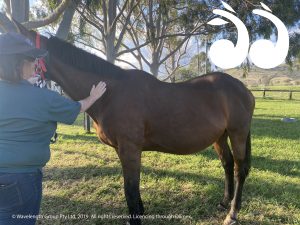
Julie Harris with a pregnant mare, due to give birth at any moment.
“We’ve actually got a vet from Scone Equine who has been monitoring nine mares on the farm…checking the heart beat of the foal and how the fluid is around the foal,” said Ms Harris.
Vets treat pregnant horses similar to how an obstetrician would treat a pregnant human, sticking with the same mare throughout the pregnancy term.
“One vet has been with a mare since day 45 of her pregnancy and she’s about to foal this month,” Ms Harris said.
“We’re excited to see a healthy new foal soon and without that vet that might not have been possible,” she said.
“We have found it very beneficial, some of the mares need antibiotics, some need other medications to get them through their pregnancies and if we didn’t do this, some of them wouldn’t carry their foal to the full term,” said Ms Harris.
An Extraordinary Team
Ms Harris said above all, dedicated staff are the most important part of the foaling season.
“A lot of people don’t realise how much effort goes into it,” Ms Harris said.
“We start watching mares from the end of July and go right through until the last mare’s due, which for us, is the end of November, could be early December,” she said.
“The big thing is, getting the right staff because you’ve got to love the job, work weekends and without passion for the job you might miss something crucial,” she said.
“I’ve taught a lot of people on the foaling side and it’s amazing when they get into it, where they go with the job,” said Ms Harris.
Holbrook Thoroughbred staff Marissa Budd and Abby Sohier, have different experiences when it comes to horses.
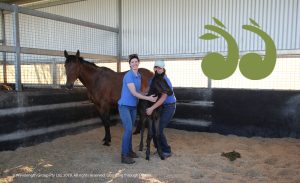
Marissa Budd and Abby Sohier with a mare and her new adopted foal.
“I was originally doing vet nursing for small animals but I wanted to come back to the big animals,” Marissa said.
“I love getting them out, seeing them grow but I also love the nursing side of things, the treating or injuries, because here we’re very hands-on,” she said.
“I was out mustering cattle before this, I prefer handling them rather than riding them every day, it’s definitely different,” Abby said.
“The foaling is adorable, very different than cows, cows you just leave and say ‘okay go calve yourself,'” she said.
Before Foaling
Well before foaling season begins in July, the Holbrook team ensures all foaling yards and paddocks are clean and full of grass.
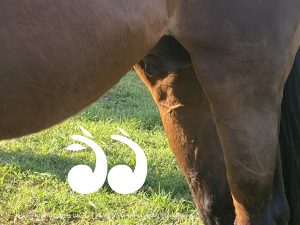
Lactation wax a mare who is due to foal soon.
Ms Harris said all mares behave differently before they foal and must be monitored 24/7 in the weeks leading up to foaling.
“Generally the mares will get wax on their teats, or may look restless and uncomfortable, but there are no set rules,” Ms Harris said.
“It’s like humans, they can give birth anytime, day or night, so it’s 24 hour surveillance,” she said.
“We always need a staff increase, I’ve got four who do night-watch shifts which start at 7pm and go through to 6:30am,” she said.
“You’ve got to love the job to do it, I’ve got two ladies who do night-watch and that’s all they do…you really rely on your night-watch people, they are the back bone of your business,” said Ms Harris.
An eye for detail is crucial when monitoring the pregnant mares, as they can be subject to birth risks similar to humans and staff are highly attuned to see any signs of complications early.
“Nutrition is a big thing for pregnant mares, we feed these mares everyday twice a day sometimes…you’ve got to be able to look at the mares and go, ‘that mare needs more, that mare needs less,'” Ms Harris said.
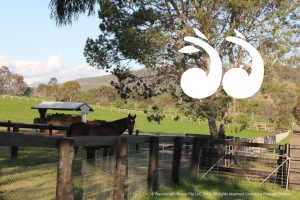
When a mare is about to give birth they are brought into the foaling yards, then once the foal is stable enough it is brought into a stable for five days.
“The foal could be presented the wrong way, could be coming out backwards, could be upside down, the foal could have one leg too far back, come out not breathing in which case we have oxygen tanks ready to give them when they come out,” she said.
“Some horse studs have their own vets but for most we have them on-call and it takes half an hour for the vet to get here so you’ve got to be able to pick when something’s wrong and call a vet, you’ve got to act,” she said.
“Staff have to know how to predict problems, you’ve got to know what you’re doing, because we’re trusting these people to foal down hundreds of thousands, millions of dollars worth of horse flesh,” said Ms Harris.
After Foaling
After birth, Holbrook staff must check the mares for any trauma including tears, bleeding, retained or placenta colic and ensure the mare has enough milk to feed the new foal.
“The mares are usually okay after birth, but you need to make sure they’re not uncomfortable or watch for bleeding,” Ms Harris said.
“We’ve had mares this year that have bled, you’ve just got to monitor it and make sure they’re healthy, eating, happy and comfortable,” she said.
Ms Harris said staff rely on the ‘one, two, three rule,’ to ensure the foal is responding to its new environment.
“In the first hour you like to see the mare and foal get up, by the second hour you’d like to see the foal sucked and by the third hour you’d like to see the mare lose the placenta,” Ms Harris said.
“The ones that we’ve been treating, they could have what we call a dummy foal and not be able to suck,” she said.
“I have seen foals get up and not know where they are, you have to make sure they drink,” she said.
After birth, new foals should be bright, alert and responsive, with no limb or eye deformities and their umbilical cords need to be sprayed with iodine to fight infection.
“One of the main things a foal can get, which is a very deadly thing, is ‘joint ill’, an infection in the bone and that can be ingested through the nose or come through the umbilicus and that’s why it’s really important to keep things clean,” Ms Harris said.
“We then test the foals blood IgG level (immunoglobulin type G) and the quality of it,” she said.
“Colostrum helps fight infection, if the mare doesn’t have good quality colostrum then the foal is more prone to infection,” she said.
“We collect colostrum from the mares and if the foal colostrum reading comes back at 19, we supplement it and if that doesn’t work we go for a plasma transfusion, but that’s very expensive,” said Ms Harris.
Marissa Budd said there are incredibly effective procedures available to help straighten the foals legs.
“We can do a lot to fix their legs…some of them come out with contracted tendons so their legs won’t actually sit right, some drugs will help with that or you can put splints on,” Marissa said.
“We’ve had some this year that have gone into the vet to have strip surgeries, where vets agitate the bone and it makes the bone grow a certain way and that’s a minor procedure where the results are amazing,” she said.
“The ultimate goal is to get the best racehorse, you want the legs as straight as you can,” said Marisaa Budd.
The Bonding Period
Post birth, mares and foals are transferred into a stable for five days and then over to nine-day yards, to allow for monitored bonding time.
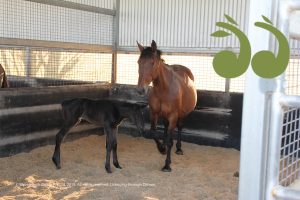
When the foal is born and is stable enough, the mare and foal are brought into a stable for five days.
“It is an amazing thing to watch when you see the mares have their first foal, what we call the maiden mares, see them bond with the foal, it is truly the loveliest thing to watch…they just adapt and learn to go with it,” Ms Harris said.
“The foals come out and they’re whining, carrying on and the mare looks at it and goes, ‘what’s that?'” she said.
“We had a mare come here last year and they didn’t think she’d become a good mother, but she foaled the other day and she’s one of the nicest mares out,” she said.
“She was overprotective when she first had the foal and we had to help her out, but we left them alone in the nine-day yards for a little bit longer and made sure we didn’t rush the situation.
“Once the foals get older they break away and they wont follow their mother and that’s very annoying for the staff,” she said.
“You’ll have a foal standing there in the middle of the paddock with his mates like, ‘I’m not going!'” said Ms Harris.
Saying Goodbye
A mare will generally take a year off breeding every four to five years and will stop breeding at approximately 18 years of age.
The Holbrook Thoroughbred team said saying goodbye to their new foals is hard, but by that time they are already focused on the next foaling season, with covers well and truly underway.
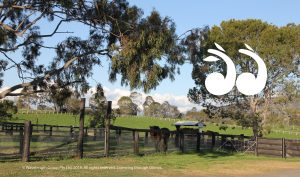
After the stable, foals and mares then go to the nine-day day yards and when the foals legs are good enough they can go into the paddock
“We’ll sell some as weanlings, some as yearlings and some will return to clients as racehorses in May or June,” Ms Harris said.
“It depends what the client wants,” she said.
“We’re already doing covers now, it’s basically non-stop,” said Julie Harris.
Tags: foaling season, Holbrook Thoroughbreds, horses, stud farm
 scone.com.au
scone.com.au